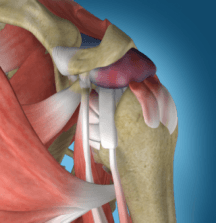Shoulder Impingement
Various supporting structures aid in the smooth movement of the shoulder joint. The joint is held together and stabilized by a group of tendons called the rotator cuff. A fluid-filled sac called a bursa, located above the rotator cuff, helps in the frictionless movement of the shoulder. Shoulder impingement is one of the most common causes of pain in the adult shoulder.

What are the causes of shoulder impingement?
Impingement results from pressure on the rotator cuff from part of the shoulder blade (scapula) as the arm is lifted, inflammation of the bursa (bursitis), or irritation or damage of the tendons (tendonitis). It is more likely to occur in young and middle aged people who engage in physical activities that require repeated overhead arm movements.
What are the symptoms of shoulder impingement?
Shoulder impingement may cause severe pain at rest and during activities, weakness and stiffness of the arm, and difficulty in raising the hand overhead.
How is shoulder impingement diagnosed?
Diagnosis involves a physical examination by your doctor to check for the possible range of movements with the affected shoulder. X-rays and MRI scans may be ordered to view the injury and inflammation.
What are the treatment options?
Shoulder impingement can be treated with rest, ice packs, anti-inflammatory drugs and avoiding the activities involving the shoulder. Physical therapy may be advised to strengthen the muscles and steroid injections may be administered. If pain persists, open or arthroscopic surgery (minimally invasive surgery performed with a narrow tube fitted with a camera) may be considered to remove bone spurs and bursa and repair partially torn rotator cuff tendons.













